Lab Research Results
The two major seasons of work at Hinds Cave yielded a very large set of artifacts and samples of many different sorts. In fact, the magnitude of the sampling program was unprecedented in the Lower Pecos region and has not been duplicated since. From the outset it was recognized that the wealth of collected materials would allow many different kinds of specialized studies to be undertaken and most would be labor-intensive. Thirty years later, collections remain an important source of ongoing research projects for students and specialists.
Dozens of research projects based on Hinds Cave samples have been carried out successfully during the past three decades. Much of this research has been done by graduate students and established specialists interested in combining their own research interests and questions with particular kinds of cultural material. What follows is a brief summary of the major completed studies. Most are Master’s degree theses or Ph.D. dissertations. Some of these were published by the Department of Anthropology at Texas A&M University in a special publications series. A total of five soft-cover, limited-edition (100-200 copies) technical reports, here termed the Hinds Cave Reports, were issued; all had a common cover design featuring a drawing of Hinds Cave. There have also been many articles in scholarly and popular journals. A complete list is provided in Credits and Sources.
Shafer and Bryant 1977: The initial published summary and results of the Hinds field research is the 1977 annual report to the National Science Foundation written by Harry J. Shafer and Vaughn M. Bryant (Hinds Cave Report 1). This is the starting place for all Hinds Cave research. The report explains the purpose of the research, outlines field strategies, and summarizes what was accomplished during the two major field seasons. There are also summaries of the preliminary results of laboratory analyses then underway which were co-written by many of the graduate students whose studies are summarized below.
Williams-Dean 1978: The first major lab research project to reach completion was Glenna Williams-Dean’s 1978 dissertation study at Texas A&M ( Hinds Cave Report 2). She analyzed a sample of 100 coprolites from Lens 13, a thick latrine layer in Area B that has been well dated to about 4600-5200 B.C. (6570-7165 B.P., calibrated midpoint range.). This amusingly titled "Consumption Residue Analysis Project" is the largest and most thorough study ever completed of coprolites from the Lower Pecos Canyonlands. Williams-Dean pioneered many of the processing and analysis methods used by subsequent researchers. Samples of each coprolite were chemically reconstituted so that the constituent parts including fibers, seeds, animal bones, fur, insect parts, pollen, and so on could be separated and identified. Several volunteers ate special kinds of foods and monitored their own diets over periods of several weeks. The modern "coprolites" from the unnamed Subject B served as baseline control samples. These results strengthened the dietary inferences that could be drawn from the ancient coprolites.
Williams-Dean earned her Ph.D. in botany through a special interdisciplinary program that allowed her to combine archeology, physiology, zoology and botany, a daunting suite of academic specialties, but one that was essential. Archeology provided the samples and the basic problem orientation. Physiology was needed to understand how the human body processes food and excretes the non-digestible by-products and residue. Ken Lord identified the many animal remains, the most common and important of which appeared to be rodents. Entomologists helped identify the insect remains. Williams-Dean used her botany skills to identify plant remains, some macroscopic and easily seen under low magnification and some microscopic. One critical microscopic component of Dean’s analysis was the identification and quantification of plant pollen. This highlighted the role that pollen plays in the interpretation of prehistoric diets.
The picture that emerged from Williams-Dean’s coprolite study was that of an Early Archaic hunting and gathering life based heavily on the consumption of three plants, pear cactus, lechuguilla, and sotol, and many small animals, especially wood rats and mice. Keep in mind that this diet does not necessarily or even likely represent the year-round diet, but instead what people were eating while they stayed at Hinds Cave. They ate what was available in a semi-arid desert canyonland environment and seemed to have sampled almost anything and everything that could be eaten from cactus to seeds to nuts to fruits to small mammals to reptiles to birds to fish. The diverse prehistoric diet was judged to be healthy based on several factors including the absence of intestinal parasites and, somewhat suprisingly, the lack of intestinal bleeding from the coarse diet. But food consumption was very different that of modern peoples. Rodents and lizards, for instance, were minimally prepared before consumption and appear to have been eaten essentially whole with little or no cooking. Hair, bones, tails and all. Dean found feathers and beaks from birds, lizard skin and bones, fish scales and bones, and so on.
Dering 1979: The pollen and plant macrofossil vegetation record from Hinds Cave was studied by J. Phillip Dering for his 1979 Master of Science thesis ( Hinds Cave Report 3). Like Dean, Dering’s degree came through the Department of Botany at Texas A&M rather than Anthropology. During the fieldwork at Hinds, Dering collected columns of small soil samples from several of the most intact and informative stratigraphic profiles. The pollen preserved in these samples was identified and quantified and compared to modern pollen samples collected from natural water holes and surfaces near the site. The macrofossil (or macrobotanical) samples – or visibly recognizable plant remains such as leaves, wood, charcoal, and fiber – came from the many bags of dry plant remains collected from each excavation area. He also studied and quantified the modern plant communities at 18 localities in the region surrounding Hinds Cave.
Dering used these botanical data sets to reconstruct his view of the past climatic and environmental conditions that prevailed at Hinds Cave and then compared these to modern conditions. Broad trends through time could be seen from cooler and wetter conditions to drier and warmer conditions very much like those found today. From the macrobotanical samples, Dering identified dozens of different plants that prehistoric peoples had brought to the shelter for food, fuel, tool use and to meet special needs.
Andrews and Adovasio 1980: Two outside researchers, Rhonda L. Andrews and James M. Adovasio of the University of Pittsburg published a detailed study in 1980 of what they termed the “Perishable Industries” at Hinds Cave. By this term they mean certain classes of artifacts constructed from perishable materials including basketry, cordage, netting, and knotted fibers. (The site’s large collection of sandals was not included in the study.) The 375-page hard-to-find, limited-edition report describes and categorizes some 2000 perishable artifacts.
Stock 1983: Janet A. Stock’s 1983 M.A. thesis from Texas A&M was the second coprolite study from Hinds Cave ( Hinds Cave Report 4). Stock analyzed 55 coprolites selected from two latrine deposits that dated to about 5700-6300 B.C. (Area C) and 7200-7300 B.C. (Unit D). Both deposits were earlier than that studied by Dean, and the coprolites from Unit D were, in fact, the oldest coprolites ever dated (at the time) from the region. Stock’s study found that the earlier Hinds Cave coprolites essentially reflected a diet very similar to that described by Dean. She documented, however, evidence of the consumption of several different animal species and details on food preparation not seen in the earlier study.
Lord 1984: Kenneth J. Lord from the University of Texas at Austin undertook the analysis of a large sample of animal bones collected from Hinds Cave for his 1983 dissertation (published in 1984 as Hinds Cave Report 5). Animal bones were numerous and extremely well preserved in the Hinds deposits. Lord chose samples from different excavation areas and layers within the shelter to enable him to look at changing patterns through time. By looking at all the bones instead of just those small enough to pass through the digestive system and emerge in coprolites, Lord could see that deer, carnivores (raccoon, skunk, fox, etc.) and rabbits also played an important role in the local diet.
Lord identified the bones of some 70 different animal species at Hinds Cave, most clearly food items consumed by prehistoric peoples. Collectively, these species show that Hinds Cave residents hunted, snared, netted, and grabbed a diverse range of animals representing the canyon habitat as well as those of the riverine and uplands habitats. The identified remains included 36 mammals, 10 birds, 8 fish, 6 lizards, 4 rattlesnake species, 4 turtles, and 2 frogs. Among the mammals were 3 kinds of rabbits, 4 kinds of squirrels, and 14 rodents (rats, mice, and gophers) as well as larger species including white-tailed and mule deer, pronghorn, mountain lion, fox, coyote, and otter, among others.
Although the smaller animals—rodents, rabbits, fish—occurred in far larger numbers, by calculating the meat yield represented by the individual animals, Lord found that the bulk of the meat came from deer throughout the history of the site. There were noticeable shifts in the importance of some kinds of animals through time.
Saunders 1986: Joe W. Saunders from Southern Methodist University completed an ambitious dissertation study in 1986 based on his own archeological survey work around Hinds Cave, a synthesis of previous dietary studies of the site’s materials, and his own analysis of projectile points from Hinds. Saunders summary of the Hinds Cave work stands as the most complete and up-to-date overview of Hinds research until the present web exhibit. Unfortunately, his dissertation research was never published, apart from a journal article on his survey results.
Saunders study helps us better understand how prehistoric peoples used Hinds Cave as part of the wider landscape. Through time, the upland areas immediately overlooking the side canyons and main Pecos River were used intensively for both hunting and, especially, plant gathering and processing (as well as small game trapping, etc.). In contrast, the more distant uplands evidenced mostly hunting and relatively little gathering. This pattern suggests that people camped in the canyons and, probably more often, in nearby upland settings overlooking the canyons. A full range of economic activities took place in this primary residence zone, especially plant gathering and processing, activities most strongly linked to women and children. Male hunting parties ranged over much larger areas, likely in search of their favorite prey and most important meat source, deer.
Reinhard 1988: Karl J. Reinhard studied a sample of 25 Hinds Cave coprolites as part of a larger Ph.D. study of the health and nutrion of agricultural and non-agricultural prehistoric societies in the American Southwest. The Hinds Cave sample came from Middle Archaic period deposits in Area B (Lenses 5 and 7). Based on a single radiocarbon assay, these deposits date to approximately 2000 B.C., thousands of years later than the Early Archaic coprolites studied by Williams-Dean and Stock. Reinhard results suggest that the basic diet remained essentially unchanged; minor differences were noted but certain of these may be due to sampling error. Reinhard sampled fewer coprolites and studied smaller portions of each one than was the case with the earlier studies. This study is unpublished, although summary articles have appeared.
Edwards 1990: Sherrian K. Edwards’ 1990 M.A. thesis presents an analysis of 40 coprolites from the upper two layers in Area B at Hinds Cave. While these layers are assumed to date to the Late Archaic, none of the coprolites or directly associated materials were radiocarbon dated. Edwards’ concludes that the same basic diet seen in the Early Archaic coprolites analyzed by Dean and Stock remains essentially unchanged in the assumed Late Archaic coprolites. The study is unpublished.
Woltz 1998: Ben V. Woltz, Jr, completed a M.A. thesis in 1998 on the use of lechuguilla, sotol, and yucca at Hinds Cave. This unpublished study details processing methods used for each of these major plants, but presents little new data. Lechuguilla is judged to be important as a food resource and as a source of strong fibers. Sotol is said to represent a relatively minor food resource, but its leaves were heavily used for basketry. Yucca is not considered a food resource, but its leaves were commonly used in basketry and is fibers used to make strong cord.
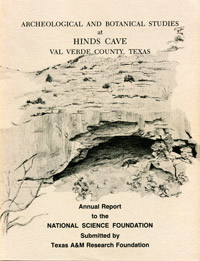
Hinds Cave Report 1
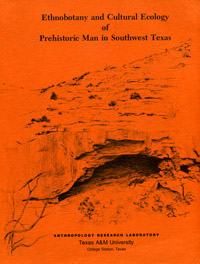
Hinds Cave Report 2
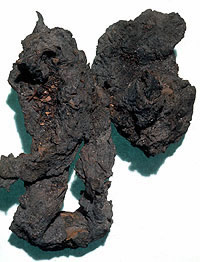
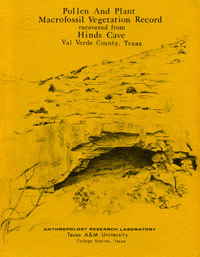
Hinds Cave Report 3
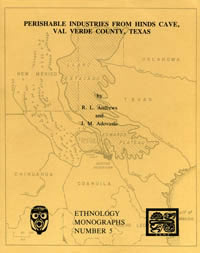
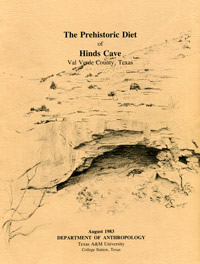
Hinds Cave Report 4
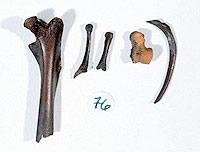
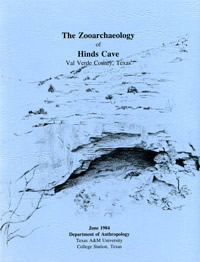
Hinds Cave Report 5